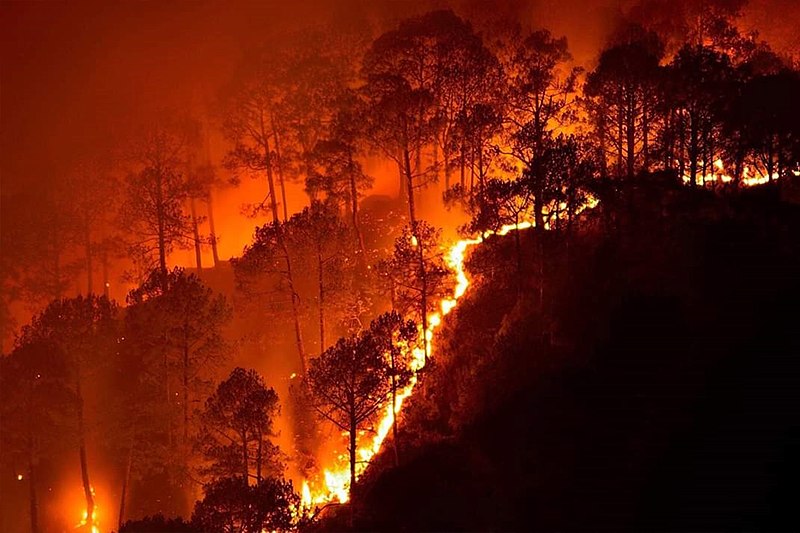India witnessing a frenzy of forest fires in 2021
In the three months since January 1, 2021, Uttarakhand has witnessed over 1,000 wildfires, 45 in one day in early April, claiming the lives of five people and seven animals. While the fires in Australia and Amazon grabbed global attention, few paid heed to wildfires raging in India.
With over 24,303 sq km or about 45 pc of the total landmass of Uttarakhand being under forest cover, the state is even otherwise prone to forest fires, especially in the dry season or after prolonged spells of drought. Several districts of the Himalayan state, ranging from Pauri Garhwal and Dehradun in the Garhwal region to Nainital and Almora in Kumaon, says the Forest Survey of India (FSI), Dehradun.
The forest fires witnessed since January 2021 are being linked to the dearth of rainfall in 2019 and 2020 and large quantities of dry leaves and pines found on the forest ground. But experts say that human involvement in the fires cannot be overlooked.
“Uttarakhand, where pines are found in abundance and can catch fire quickly, carelessly throwing a lit cigarette or intentionally burning parts of the forest to clear the land or even natural causes may have been the reason. But no one can say for sure what may have been the exact cause,” Rekha Lalla, programme manager with the Climate Reality Project India, an organisation which works to provide climate education and empower communities to take climate actions, tells Media India Group.
According to the Indian State of Forest Report 2019, over 30,000 incidents of forest fires were reported in India in 2019. Along with that, more than 36 pc of Indian forest cover or about 657,000 sq km area is prone to frequent forest fires and of this, 10 pc are highly prone and around 21 pc of the total forest cover is highly to extremely fire prone, says another report by Forest Survey of India (FSI), 2019.
“Everywhere in the world forest fires are observed whether it was Amazon or the Australian fires. So it’s not like these instances are only concentrated in India. It is also a natural process, as they are also a part of nature and play a role in shaping the nature and the ecosystem, a renewal of the same, but as observed by me in my career, around 85 pc of fires are caused due to human activities,” explains Lalla.
Humans main cause of forest fires
Forest fires are considered to be a natural phenomenon caused by a variety of reasons ranging from lightening and high temperatures to friction between dry branches, but over the years human intervention has become the major reason of the increase instances of wildfires.
Various studies have linked the rising cases, increasing intensities and longer duration of these fires to climate change and extensive deforestation.
In India, fires are primarily caused by human activities, notes the FSI technical study, with over 95 pc of fire incidents of anthropogenic origin.
“When we say forests, there are only three things, fuel, oxygen and heat. So some small spark, due to a lit cigarette thrown somewhere, have been observed to cause large fires. As forest floors have a lot of dry material like leaves, twigs and pines,” says Lalla.
Wildfires, when caused by natural reasons are welcomed as they help maintain a balance in the eco-system, but if not controlled in time or if they occur more frequently due to human activities, they can lead to devastating outcomes. For instance, around 6.3 million hectares of forests in Australia and around 0.72 million hectares of forest and grass land in California were destroyed by fires. In India, where such large-scale losses do not occur, 4,800 hectares of forests were lost during the February 2018 Bandipur Tiger Reserve fires in Karnataka.
“The loss of biodiversity especially the animals, their homes are destroyed. They are the worst affected. The air pollution and soil degradation is something that impacts the people living in regions closer to the fire prone areas. As soil becomes hydrophobic after the fires and is unable to absorb the water, also due to dearth of trees, the rainfall erodes the top soil causing infertility in the region,” says Lalla.
In the advanced version of the Forest Fire Alert System, originally put in place by FSI in 2004, forest fires are being monitored in real time with the help of satellite information gathered from NASA and ISRO. Since January 2019, the system also gathers real-time fire information from identified fire hotspots using Moderate Resolution Imaging Spectroradiometer (MODIS) sensors. This information is then relayed via email at various levels of administration to take preventive measures and residents of the areas under threat are notified through SMS messages.










